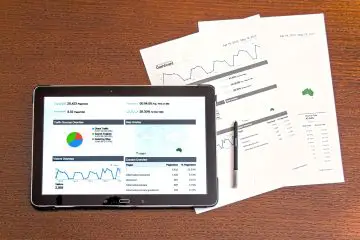Some time ago Google announced that page speed – the speed of your website – affects your ranking. How quickly your page loads and creates opportunities for interaction becomes a ranking factor that influences your SEO overall.
Of course, one question now shoots through your head: What can I do to make my website run faster and rank better? In the following article we give you an overview of the topic of page speed – and show you optimization possibilities!
What does page speed mean?
Pagespeed describes the speed of a website in terms of its loading time. So it’s about the period of time between the specific request of a website (by clicking on a link or typing in the browser window) and the point at which the website is fully loaded and usable.
Of course, this also includes the loading speed when users navigate back and forth between different subpages of a website. Overall, the point at which the website can really be used is important.
So it’s no use if an initial overview is loaded quickly, but buttons & co. are loaded gradually. All in all, this definition of page speed is not just limited to pure speed but is primarily to be seen in connection with the user experience.
Why page speed is important for Google
Google is constantly working on the to optimize your own service as a search engine. Ultimately, the goal is to present users with search results that are as ideal and satisfactory as possible. The algorithm is regularly adjusted for this.
The development towards a stronger focus on page speed is only logical overall. Eventually, only the mobile version of the site will be indexed. It is therefore particularly important for the user experience that, in the spirit of the constant availability of the Internet, everything loads quickly and is played well. Otherwise, the users are frustrated – and jump off.
Google would like to prevent that. After all, all these changes are about one thing above all: the user experience should be optimized. No wonder, then, that speed plays a major role.
The site speed at Google – part of the ranking factor “User Experience”
First of all, you need to know that page speed is only one factor within a larger cluster. Overall, this cluster deals with the user-friendliness of your website. Pure speed is therefore only one building block of a larger ranking factor. Roughly speaking, the overall picture of user experience consists of three key questions.
1. Is your website secure?
In order for the website to provide a pleasant experience for users, it must be designed to be secure. This refers on the one hand to the connection (HTTPS/SSL) and on the other hand to whether viruses, spam, or malware emanate from this website.
The latter is ideally not a problem with your website. You can quickly check the former in a browser like Chrome. When you go to your website, a little padlock will appear in front of your URL. This is either closed or open. Click on it to get information about whether your website is providing a secure connection. If this is not the case, you should request a corresponding SSL certificate, etc. from your domain host.
2. Is your website mobile-optimized?
We have already written extensively about the Mobile First Index elsewhere. All in all, the mobile optimization of your website naturally belongs to the user experience cluster. Because nothing is more awkward than a desktop design that is simply scaled down to fit the smartphone screen.
So be sure to look for a mobile design, even think explicitly about the mobile design in the conception, and then adapt it for the desktop. Important parameters are the font size and the usability of content elements (buttons, accordions, forms…). All of these factors severely detract from the user experience – after all, it’s incredibly frustrating to keep hitting the wrong button because they’re too small or too close together.
3. Is your website fast?
Only one of three user experience questions is about speed. This question is not only aimed at page speed alone but also includes other factors from the core web vitals such as a stable design. Remember, site speed isn’t just about speed, it’s time to total usability. This also includes that no more elements are moved, etc.
Only the basic, technical factors are taken into account here (how much time passes until the main content is loaded? How long does it take until the website is usable? Does the design remain stable, or do elements still move afterward?)
So you shouldn’t do anything about speed subordinates. First, make sure you have good content and a secure, mobile-optimized website. Because bad content will never rank and neither will an insecure website. Once you have fulfilled this “mandatory part”, the optimization of the page speed becomes a free choice, which in the end can then offer you a decisive advantage over the competition.
Tools for easy insights into your site speed
There are several ways to with which you get insights about the page speed. A simple variant is the Google Search Console. This gives you all the relevant facts about the Core Web Vitals. All you have to do is enter your domain and data will be collected.
In addition, you can access the PageSpeed tool directly from the Search Console, which records the speed as a number from 0 to 100. An alternative to this is e.g. B. also Lighthouse. The assessments of these tools are good for getting an overview of the overall speed. Please note, however: Not everything that flows into the measurement result with these tools is necessarily SEO-relevant.
SEO optimization: This is how you increase your page speed
To your site in stuff To optimize page speed for SEO, you should primarily focus on the Core Web Vitals. Collect and monitor them regularly using a tool of your choice. If the values are too low, you should carry out optimization measures. In doing so, you orientate yourself step by step on individual factors.
Test the changes extensively before publication – and afterward, determine whether the change has also brought the desired success. This is how you make it step by step into the green area in terms of page speed.
If the Core Web Vitals are satisfactory, then you can refer to additional speed tips from Pagespeed/Lighthouse. However, this is more of an encore and tends not to be SEO relevant. Possible optimization approaches here are:
- Plan the header of your website as resource-saving as possible. Do not use a slider, but instead a hero image, which may load randomly from a selection of several images. This reduces the loading effort.
- Compress images and videos. Such elements are often installed in too high a resolution for web use. Here you can easily reduce the amount of data.
Do not use complex forwarding structures to reduce additional loading processes.
- Also pay attention to technical aspects such as browser caching, server response times, and JavaScript and CSS resources.
- Constant monitoring: keep it Always keep an eye on the performance of your website and take action if necessary.
Please keep an eye on it: A fast website does not necessarily promise good rankings. Speed is just one of many factors and should never be the top priority. First create a safe, mobile-friendly website and then build unique content that meets the search intent of your target group. Only then comes the page speed optimization.
If your site ranks poorly or not at all, it is usually due to other technical aspects of the site and content first. The speed is more of a kind of bonus to end up beating out the competition when it comes to accurate rankings.







